JRDG Company Special – Model 302, 301, 312, 304
Model 302
2002-2009
Retail prices in 2007 in Germany:
Model 302 2 x 300 W – ICE-Pack-Amp 17.398,00
Model 302-handles 2 x 300 W – as above, with handles 17.998,00
Model 302/4 – 2 x 300 W – 4-Module-Amp for Bi-amping. 18.698,00
Model 302/4-handles – 2 x 300 W – as above, with handles 19.398,00
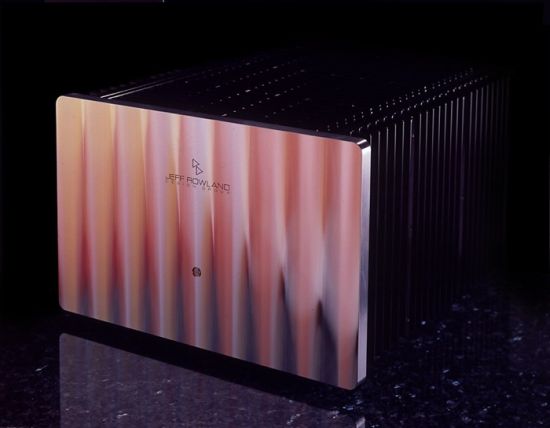
Rowland’s 302 was the first high end approach to using ICE-power. Inside is a huge power transformer but it isn’t used in the regular way, instead it is used for filtering. After that follows the power factor correction, followed by a switched power supply. This amp can be fitted with one, two or four ICE-power channels according to taste. With 2 channels installed, 300 watts are available, dropping to 250 watts when 4 channels are installed. This is because the modules are fed from the same 1200 watt power supply.
Model 301, 312, 304
Approx 2009-2012
Retail prices unknown
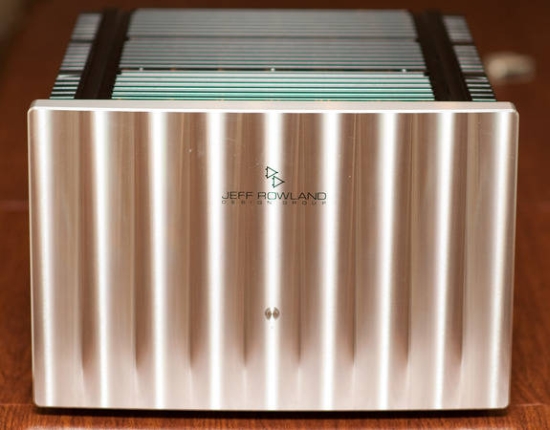
Housed in the same chassis, but following up on the model 302 this is the next high end approach to using ICE-power. As far as I can find out these models use the same electronics as thhe previous 302. Perhaps it was only a nomenclature change. Inside is a huge power transformer but it isn’t used in the regular way, instead it is used for filtering. After that follows the power factor correction, followed by a switched power supply. This amp can be fitted with one, two or four ICE-power channels according to taste. With 2 channels installed, 300 watts are available, dropping to 250 watts when 4 channels are installed. This is because the modules are fed from the same 1200 watt power supply. The 301 is mono, 312 is stereo and 304 is 4-channel.
Two generations of 301
There were two generations of 301, the second gen starts with serial number 72. The most obvious difference is in the ICE power module used but there’s more. See below for a complete overview.
Serial numbers and production years:
- Original version units of the Model 301 have serial numbers ranging from MA0002 through MA0071. These units were manufactured from March 2003 through October 2005
- New version units of the Model 301 have serial numbers starting from MA0072 and higher. These units were manufactured from November 2005 to the present.
Different front end power supplies for the second generation:
- Original version utilizes a isolation power transformer followed by two 700W power factor correction (PFC) modules, followed by two 600W
- Vicor DC-DC converters.
- New versions eliminates the transformer and utilizes a single universal AC input 1200W active PFC/SMPS module.
- Both utilize the same low voltage power supply.
ICEpower modules:
- Old – ICEpower500A MK2 modules
- New – ICEpower1000ASP modules
Output power rating differences:
- Old, parallel: 400W @8 ohms, 650W @4 ohms
- New, parallel: 600W @8 ohms, 1200W @4 ohms
Model 301 Pictures
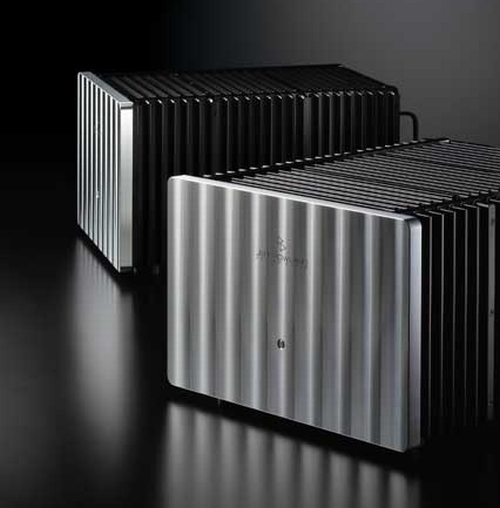
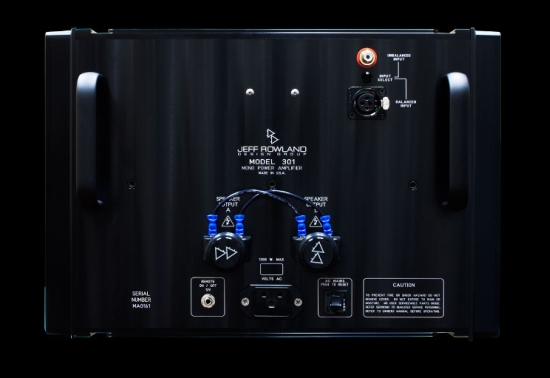
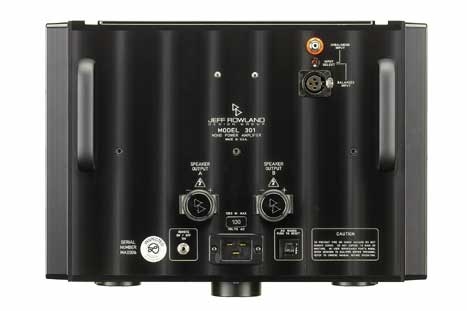
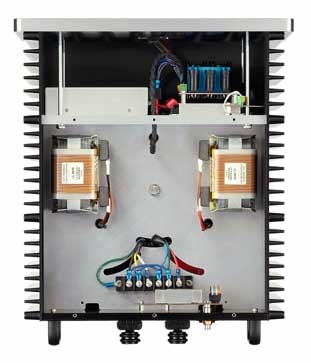
Above you can see the bottom section of the 301’s insides. The metal plate divides the unit in two sections and the ICE power units are in the top section.
Model 302 Pictures
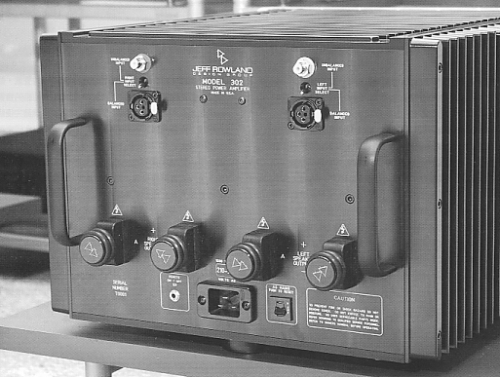
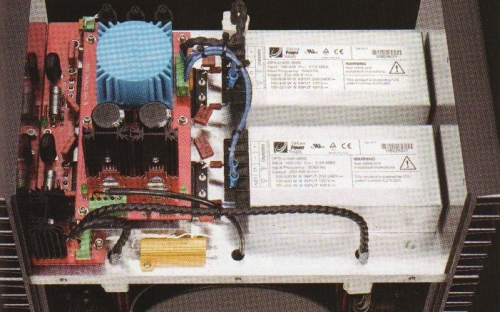
Switching powersupply on the left, bottom circuitboard and Power Factor Correctors on the right
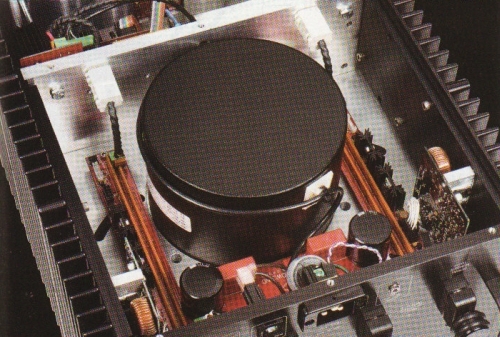
Above: 2 channel version of the model 302. The big transformer isn’t used in the normal fashion but as an extra filterstage before the swithcing power supply.
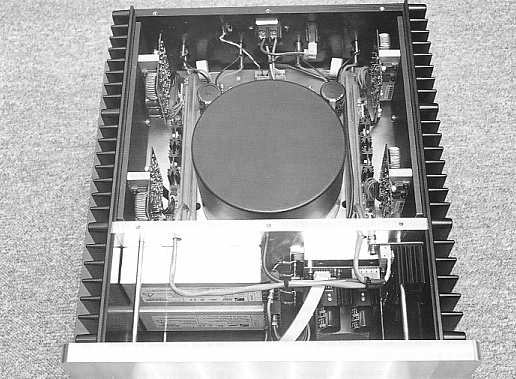
Above: 4 channel version of the model 302
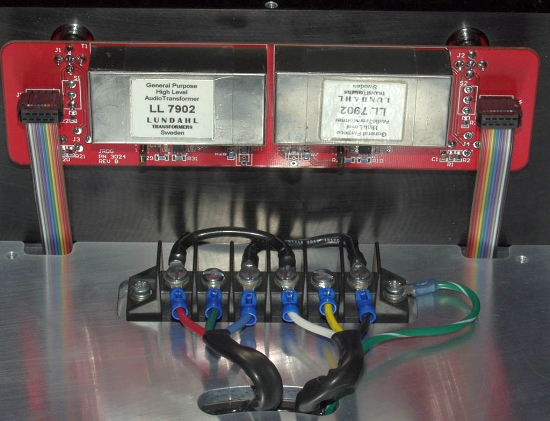
Above: input board
Model 312 Pictures
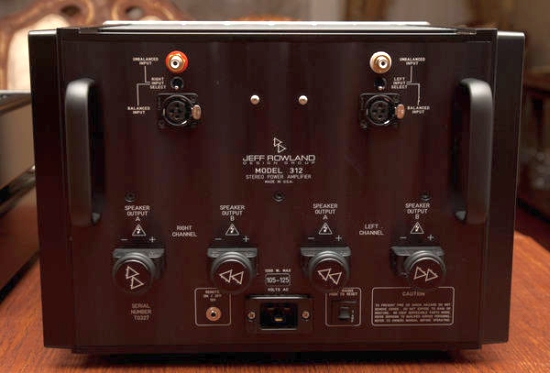
Model 312 rear is almost identical to the 302 rear panel
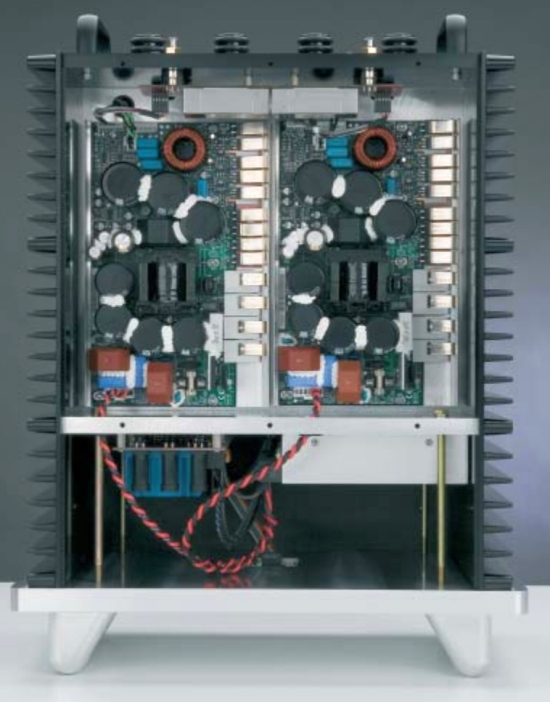
Model 312 utilises more modern ICE power modules.
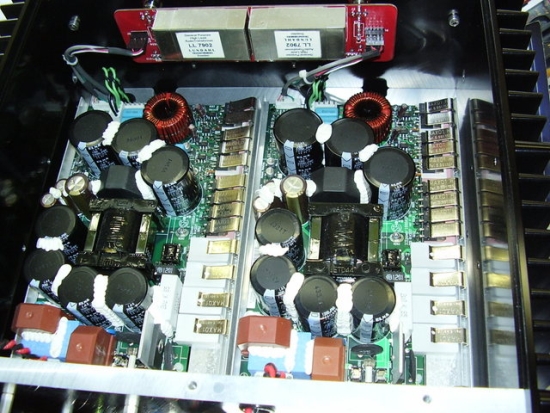
Model 301 Versions
There were two generations of 301, the second gen starts with serial number 72. The most obvious difference is in the ICE power module used but there’s more. See below for a complete overview.
Serial numbers and production years:
- Original version units of the Model 301 have serial numbers ranging from MA0002 through MA0071. These units were manufactured from March 2003 through October 2005
- New version units of the Model 301 have serial numbers starting from MA0072 and higher. These units were manufactured from November 2005 to the present.
Different front end power supplies for the second generation:
- Original version utilizes a isolation power transformer followed by two 700W power factor correction (PFC) modules, followed by two 600W
- Vicor DC-DC converters.
- New versions eliminates the transformer and utilizes a single universal AC input 1200W active PFC/SMPS module.
- Both utilize the same low voltage power supply.
ICEpower modules:
- Old – ICEpower500A MK2 modules
- New – ICEpower1000ASP modules
Output power rating differences:
- Old, parallel: 400W @8 ohms, 650W @4 ohms
- New, parallel: 600W @8 ohms, 1200W @4 ohms
Model 301 Technical Specifications
(second generation)
Output Power @ 8 ohms
Continuous RMS 1800/600 watts (ser/par)
Output Power @ 4 ohms
Continuous RMS NA/1200 watts (ser/par)
Frequency Response
10 Hz – 60 kHz, 3dB
Peak Output Current
> 90 amps
Dynamic Range
120 dba
THD + Noise
0.1W-500W/4 ohm
typ. .006% @ 1kHz
CCIF Intermod. Dist.
19/20kHz < .002%
Damping Factor
60
Common Mode Rejection Ratio
>90dB, 20 Hz 20 kHz
Amplifier Weight
80 lbs each
Amplifier Dimensions
10.6″ x 15.5″ x 18.3″
Model 302 Features
XLR input connectors for balanced system configuration.
RCA input connectors for unbalanced system configurations.
Dual Speaker Output Terminals on each channel for bi-wiring applications.
User selectable switching between balanced and unbalanced connections.
Transformer coupled inputs provide universal compatibility with other components and eliminate
ground loop noise and EMI.
Ultra-high efficiency output section generates high power output with very little heat.
Fully-balanced circuit topology implemented from input to output.
Power Factor correction in power supply reduces AC line harmonic noise pollution and increases
AC line power utilization to 99%.
Proprietary switch-mode power supply technology ensures consistent performance under all
operating conditions.
12V remote ON/OFF remote power switching via 1/8” jack on rear panel.
CE approved speaker output terminals require no tools for secure, low resistance connections.
Standby power mode reduces warm-up time.
Fail-safe operation provided by user-resetable thermal circuit breaker located on rear panel.
Quiet, transient-free operation during power ON/OFF and input configuration switching.
Selectable overall gain of 26 or 32 dB.
Ultra-low resonance, structurally rigid chassis constructed of precision-machined aircraft grade
6061-T6 aluminum.
3-point self-leveling chassis support.
Model 302 Technical Specifications
Output Power: Continuous RMS watts, both channels driven
@ 8 ohms 300 watts
@ 4 ohms 500 watts
Power Bandwidth:
5 Hz – 60 kHz, -3 dB.
Peak Output Current:
>45 Amps
Dynamic Range:
117 dBA
THD + Noise, 0.1W-500W/4 ohm:
<.05%, typically .006 @ 1kHz.
CCIF Intermodulation Distortion, 19/20 kHz:
<.002%
Damping Factor @ 1kHz:
275
Overall Gain: (Balanced or Unbalanced)
Selectable Internal Jumper,
26 or 32 dB
Input Impedance:
40k ohms
Common Mode Rejection Ratio:
>90dB, 20 Hz – 20 kHz
Absolute Phase:
Non-inverting, Pin 3 Positive
Inputs:
User Selectable,
2 x Balanced XLR
2 x Unbalanced RCA
Outputs:
2 Pairs Parallel Binding Posts per Channel
Power Consumption:
Standby Switch OFF 45 watts
Standby Switch ON (idle) 55 watts
Maximum 1200 watts
Amplifier Weight:
95 lbs./43 kg.
Shipping Container Dimensions:
27” (L) x 21” (W) x 16” (H)
68 cm (L) x 54 cm (W) x 41 cm.
Shipping Weight:
103 lbs./47 kg
Model 304 Features
XLR input connectors for balanced system configuration.
RCA input connectors for unbalanced system configurations.
User selectable switching between balanced and unbalanced connections.
Transformer coupled inputs provide universal compatibility with other components and eliminate
ground loop noise and EMI.
Four channel capability allows use in multi-channel systems as well as providing four channels of
discreet amplification for multi-amped stereo systems.
Ultra-high efficiency output section generates high power output with very little heat.
Fully-balanced circuit topology implemented from input to output.
Power Factor correction in power supply reduces AC line harmonic noise pollution and increases
AC line power utilization to 99%.
Proprietary switch-mode power supply technology ensures consistent performance under all
operating conditions.
12V remote ON/OFF remote power switching via 1/8” jack on rear panel.
CE approved speaker output terminals require no tools for secure, low resistance connections.
Standby power mode reduces warm-up time.
Fail-safe operation provided by user-resetable thermal circuit breaker located on rear panel.
Quiet, transient-free operation during power ON/OFF and input configuration switching.
Selectable overall gain of 26 or 32 dB.
Ultra-low resonance, structurally rigid chassis constructed of precision-machined aircraft grade
6061-T6 aluminum.
3-point self-leveling chassis support.
Model 304 Technical Specifications
Output Power: Continuous RMS watts, all channels driven
@ 8 ohms 300 watts
@ 4 ohms 500 watts
Power Bandwidth:
5 Hz – 60 kHz, -3 dB.
Peak Output Current:
>45 Amps.
Dynamic Range:
117 dBA.
THD + Noise, 0.1W-500W/4 ohm:
<.05%
typically .006 @ 1kHz.
CCIF Intermodulation Distortion, 19/20 kHz:
<.002%.
Damping Factor @ 1kHz:
275.
Overall Gain: (Balanced or Unbalanced)
Selectable Internal Jumper, 26 or 32 dB.
Input Impedance:
40k ohms.
Common Mode Rejection Ratio:
>90dB, 20 Hz – 20 kHz
Absolute Phase:
Non-inverting, Pin 3 Positive.
Inputs:
User Selectable
4 x Balanced XLR
4 x Unbalanced RCA.
Outputs:
1 Pair Binding Posts per Channel.
Power Consumption:
Standby Switch OFF 45 watts.
Standby Switch ON (idle) 55 watts.
Maximum 1200 watts.
Amplifier Weight:
95 lbs./43 kg.
Shipping Container Dimensions:
27” (L) x 21” (W) x 16” (H)
68 cm (L) x 54 cm (W) x 41 cm.
Shipping Weight:
103 lbs./47 kg.
Model 312 Features
XLR input connectors for balanced system configuration.
RCA input connectors for unbalanced system configurations.
Dual Speaker Output Terminals on each channel for bi-wiring applications.
User selectable switching between balanced and unbalanced connections.
Transformer coupled inputs provide universal compatibility with other components and eliminate ground loop noise and EMI.
High efficiency ICEpower® power conversion technology generates high output power with very little heat.
Fully-balanced topology implemented in both input and output circuitry.
Power Factor Correction (PFC) in power supply reduces AC line harmonic noise pollution and increases AC line power utilization to 99%.
Proprietary switch-mode power supply technology ensures consistent performance under all operating conditions.
12V remote ON/OFF remote power switching via 1/8” jack on rear panel.
Standby power mode reduces warm-up time.
CE approved speaker output terminals require no tools for secure, low resistance connections.
Fail-safe operation provided by user-resetable thermal circuit breaker located on rear panel.
Quiet, transient-free operation during power ON/OFF and input configuration switching.
Selectable overall gain of 26 or 32 dB.
Ultra-low resonance, structurally rigid chassis, precision-machined from a solid block of aircraft grade 6061-T6 aluminum.
3-point self-leveling chassis support.
Model 312 Technical Specifications
Output Power, Continuous RMS watts, both channels driven
500 watts @ 8 ohms
1000 watts @ 4 ohms
Frequency Response
5 Hz – 45 kHz, -3 dB @ 8 ohms
Peak Output Current
40 amps
Dynamic Range
120 dBa
Load Impedance Range
2 ohms – 16 ohms
Input Impedance
40k ohms
THD + Noise, 0.1 watts – 500 watts, 4 ohms
< 0.1%, Typically .01% @ 1 kHz
CCIF Intermodulation Distortion, 19/20 kHz
< .002%
Damping Factor @ 1 kHz
> 1000
Overall Gain (Balanced or Unbalanced)
Selectable Internal Jumper
26 or 32 dB
Common Mode Rejection Ratio
> 90 dB, 20 Hz – 20 kHz
Absolute Phase
Non-inverting, Pin 2 Positive
Inputs
2 Balanced (XLR), 2 Unbalanced (RCA) (user selectable)
Outputs
2 pair Parallel Binding Posts per channel
Power Consumption
Idle – 35 watts
Maximum – 2000 watts
Amplifier Weight
70 lbs. / 32 kg Amplifier
Shipping Weight
83 lbs. / 38 kg Overall
Amplifier Dimensions (H) x (W) x (D)
10.5” x 15.5” x 18.3”
267mm x 394mm x 465mm
More Jeff Rowland
Jeff Rowland Company Special Main Page
Jeff Rowland Company Special Power Amplifiers
Class AB vs Class D – Model 525 compared to Model 201, Model 10 and Model 6
Trends TA-10.2, Wadia 151, Jeff Rowland 102 and OEM ICE Power module compared